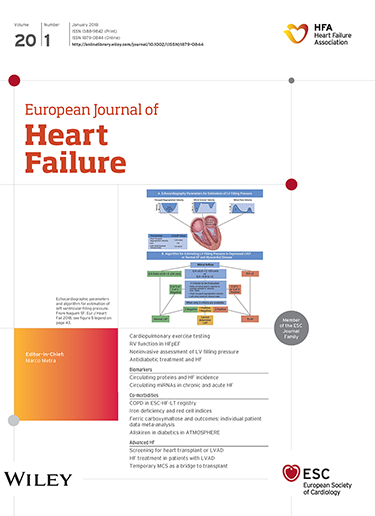June 2023 at a glance: focus on worsening heart failure, heart failure with preserved ejection fraction and valvular heart disease
IF 16.9
1区 医学
Q1 CARDIAC & CARDIOVASCULAR SYSTEMS
引用次数: 0
Abstract
Episodes of worsening heart failure (HF) are landmark events in the clinical course, followed by an increased risk of hospitalizations and death.1–5 The Heart Failure Association (HFA) of the European Society of Cardiology (ESC) provided a new definition of worsening chronic HF: worsening symptoms and signs of HF in patients with pre-existing HF, requiring intensification of treatment, most often diuretic therapy. Of note, intensification of treatment also includes escalation of oral diuretics and/or admission to ambulatory or emergency department.6 A secondary analysis of the REPORT-HF (prospective international REgistry to assess medical Practice with lOngitudinal obseRvation for Treatment of Heart Failure) registry sought to examine the utilization of healthcare resources for hospitalized patients with HF across the spectrum of left ventricular ejection fraction (LVEF). HF with reduced ejection fraction (HFrEF) was the most prevalent. The length of hospitalization was similar irrespective of LVEF. Prescription of neurohormonal antagonists was suboptimal in HFrEF at discharge, similar to what shown in other registries.7 The risk of 12-month all-cause and cardiovascular mortality were lower for HF with mildly reduced ejection fraction and HF with preserved ejection fraction (HFpEF), compared to HFrEF.8,9 Changes in plasma concentrations of biomarkers may predict the development of HF or worsening HF events.10–12 Oyama et al.13 investigated the role of three biomarkers – high-sensitivity troponin T (hsTnT), N-terminal pro-B-type natriuretic peptide (NT-proBNP), and growth differentiation factor-15 (GDF-15) – measured at baseline and at 12 months in predicting HF outcome among patients with atrial fibrillation enrolled in the ENGAGE AF-TIMI 48 trial. Serial measurement of hsTnT, NT-proBNP, and GDF-15 revealed that higher baseline values, and increasing or persistently elevated values over 1 year are associated with higher risk of HF outcomes in patients with atrial fibrillation regardless of HF history or HF phenotype based on LVEF. .. .. .. .. .. .. .. .. .. .. .. .. .. .. .. .. .. .. .. .. .. .. .. .. .. .. .. .. .. .. .. .. .. .. .. .. .. .. .. .. .. .. .. .. .. .. .. .. .. .. .. .. .. .. .. .. .. .. . Heart failure with preserved ejection fraction2023年6月概览:专注于加重心力衰竭、保留射血分数心力衰竭和瓣膜性心脏病
本文章由计算机程序翻译,如有差异,请以英文原文为准。
求助全文
约1分钟内获得全文
求助全文
来源期刊

European Journal of Heart Failure
医学-心血管系统
CiteScore
27.30
自引率
11.50%
发文量
365
审稿时长
1 months
期刊介绍:
European Journal of Heart Failure is an international journal dedicated to advancing knowledge in the field of heart failure management. The journal publishes reviews and editorials aimed at improving understanding, prevention, investigation, and treatment of heart failure. It covers various disciplines such as molecular and cellular biology, pathology, physiology, electrophysiology, pharmacology, clinical sciences, social sciences, and population sciences. The journal welcomes submissions of manuscripts on basic, clinical, and population sciences, as well as original contributions on nursing, care of the elderly, primary care, health economics, and other related specialist fields. It is published monthly and has a readership that includes cardiologists, emergency room physicians, intensivists, internists, general physicians, cardiac nurses, diabetologists, epidemiologists, basic scientists focusing on cardiovascular research, and those working in rehabilitation. The journal is abstracted and indexed in various databases such as Academic Search, Embase, MEDLINE/PubMed, and Science Citation Index.
 求助内容:
求助内容: 应助结果提醒方式:
应助结果提醒方式:


